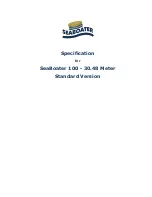
Hobie University, NAHCA
Page
26
31 Mar 02
Once hoisting the jib first I look for the sheeting angle to be correct for the sheet. I find an angle slightly higher than 45°
works for me. Then I estimate where on the Clew plate (where the sheet attaches) and the Chain Plate (where the Tack
attaches) the Jib needs to sit to achieve the correct sheeting angle.
After positioning the Jib correctly adjust the luff tension to suit the conditions. This works same as the Cunningham on
the Mainsail. Increase the tension in strong wind conditions, and reduce tension in light conditions. In strong wind simply
increase tension to remove wrinkles then pull a little more till the luff is flat and firm. Do not worry about having small
wrinkles in the luff of the sail in light wind, it is not a problem Don't forget that you can adjust the luff tension of the jib
between races if you are not happy!
Spinnaker
The most important thing with the spinnaker is to ensure that it won't have a problem being hoisted, gybed or dropped.
Ensure the all sharp edges, rings etc are well taped, that there is shock cord from shroud to shroud (in front of and above
of the diamond wires) and I also tape over the turnbuckles and anything that sticks out of the mast.
Attach the spinnaker and hoist it to ensure that everything is attached correctly before starting the race. Also drop the
spinnaker on the correct side so you hoist to leeward at the top mark.
Rig Tension
A lot of people set the rig tension the same for all conditions. On a rotating rig it is important to remember that as the
mast rotates the leeward shroud is bearing against the leeward side of the mast. This can create problems when you try to
over rotate downwind and in particular in light wind when there is no assistance from the sail to push the mast. We all
know that the leeward shroud goes slack while going upwind even in moderate wind so all rig tension is doing is holding
the mast slightly more vertical. I recommend very loose rig tension in light winds under 8 knots and slowly increasing as
the wind does (loose means that the wire is straight not flopping while on the beach).
Mast Rake
I always carry as much as I can, i.e. forestay at the top of the stay adjuster My crew weight never really exceeds 340 lbs.
For heavier crews possibly reduce the rake a hole at a time till you feel comfortable.
Rudder Set up
Most common advice is to set the rudders up parallel, however this may not be the fastest. Most boats sail with some
weather helm on the rudders and subsequently you have to pull on the tiller slightly to keep the boat in a straight line
going upwind. This means you could have a few degrees of turn on the leeward rudder that is fully loaded, however the
windward rudder that has very little load will only cause drag if it is not in line with the windward centerboard. The best
way to assess what amount of toe in you require is to sail upwind double trapeze under maximum load and watch the
water flow around the windward rudder.
When toeing in any rudders keep in mind that it should be the bare minimum as excessive toe in will harm downwind
performance when both rudders are not loaded and close to parallel is fastest (see diagram 2).
Helm is directly related to rudder rake and if you have too much weather helm (pull on the tiller) then the rudder may
have to be kicked under the boat more and if you have neutral helm it may need to be raked aft.
















































